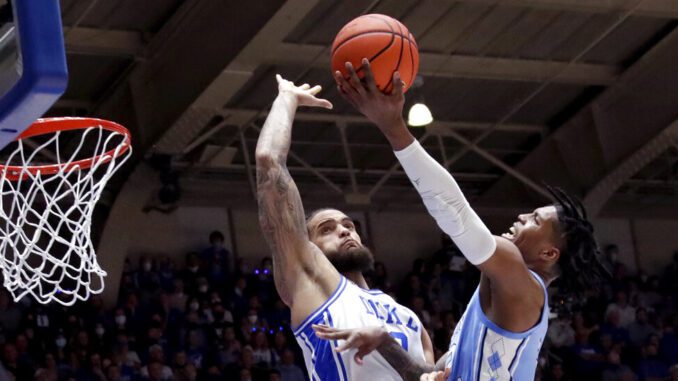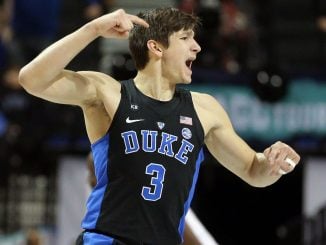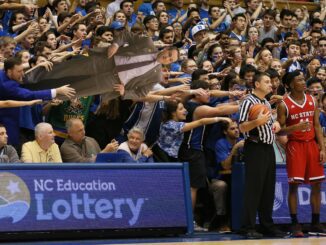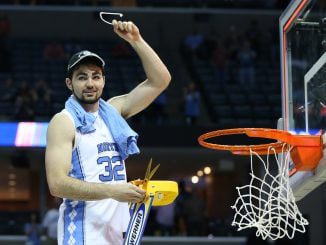
Adjustments are a part of all sports.
Hitters adjust to the way they’re pitched from at-bat to at-bat. Football offenses adjust to what defenses give them from half to half, and hockey coaches adjust to the ebbs and flows of their sport by changing their line combinations to create different matchups.
Many times, the adjustments are so subtle that they’re barely noticeable to fans in the stands and those watching at home. Other times, as with the two regular season meetings this season between basketball rivals Duke and North Carolina, they are glaringly obvious.
The Blue Devils dominated the first game 87-76 at Smith Center on Feb. 5 before the Tar Heels’ adjustments helped turn the tables a month later in a 94-81 victory that spoiled coach Mike Krzyzewski’s final game at Cameron Indoor Stadium.
Now that the teams have found themselves back on a collision course for one epic final clash in the national semifinals in New Orleans on Saturday, it’s the Blue Devils’ turn to adjust.
Here is a look back at the two previous matchups and some of the reasons why the outcomes were so different, as well as the possible adjustments that might be made for the most important game in the storied history of the rivalry:
The Bacot effect
The pivotal moment in the first meeting came in the opening five minutes when UNC coach Hubert Davis opted to have his only legitimate big man, Armando Bacot, defend Duke freshman standout Paolo Banchero. The plan backfired when Bacot was assessed with two quick fouls. Even though he picked up only one more the rest of the way, the 6-foot-10 double-double machine was never a factor, finishing with 12 points and only five rebounds.
In the second game, the smaller but more agile Leaky Black drew the defensive assignment on Banchero, and while the Duke star led his team with 23 points, Bacot more than made up the difference by going for 23 points and keying a Tar Heels offense that scored 40 points in the paint — 14 more than in the previous game.
Offensive defense
Duke’s defense didn’t force a lot of turnovers in either game, but its production off UNC’s mistakes made a huge difference. In Game 1, most of the Tar Heels’ eight turnovers were of the live-ball variety, leading to 14 Blue Devils points. In the rematch, UNC in general and point guard Caleb Love in particular did a much better job with ball security. As a result, Duke managed only two points off five turnovers.
Love committed four miscues while going just 3 of 10 overall and 1 of 5 from 3-point range at Smith Center. Although he didn’t shoot particularly well from the floor in Cameron either, going 4 of 17 (2 of 7), his increased confidence and aggressiveness helped get him to the free-throw line 12 times while committing only one turnover. The game became a springboard for a spectacular postseason that will make defending him a priority for the Blue Devils.
X-factors
Duke’s A.J. Griffin was a difference-maker in the first game, scoring a career-high 27 points on 11-of-17 shooting, including 3 of 6 from beyond the arc. A month later, though, the freshman was barely noticeable while making only two of his five field goal attempts (1 of 3 from three) and being held to five points.
On the reverse, UNC’s RJ Davis went from going 4 of 11 (0 of 3) with 11 points in his team’s loss to a much more effective 9 of 16 (2 of 4) and 21 points to key a balanced attack that saw four Tar Heels finish with 20 or more points.
If you’re looking for a potential X-factor Saturday, the Blue Devils’ Jeremy Roach is a prime candidate. His 15 points off the bench in the regular season finale led to his addition into the starting lineup in place of Trevor Keels. Since then, he’s averaged 12.5 points and 2.4 assists while adding a steadying presence that has significantly improved the Blue Devils’ fortunes late in close games.
Under pressure
Which team will handle the moment better?
The Blue Devils carried a heavy weight on their collective shoulders for Coach K’s farewell at Cameron, and it showed. The pressure has become even more intense now that each game could be the Hall of Famer’s last, but his players seem to have learned to channel it better and are playing better and looser than ever.
UNC, on the other hand, had nothing to lose and everything to gain in the regular season finale that solidified its NCAA Tournament bid. How will the Tar Heels react now that the stakes are just as high for them will go a long way toward determining who will move on to face Kansas or Villanova for the ultimate prize on Monday.



